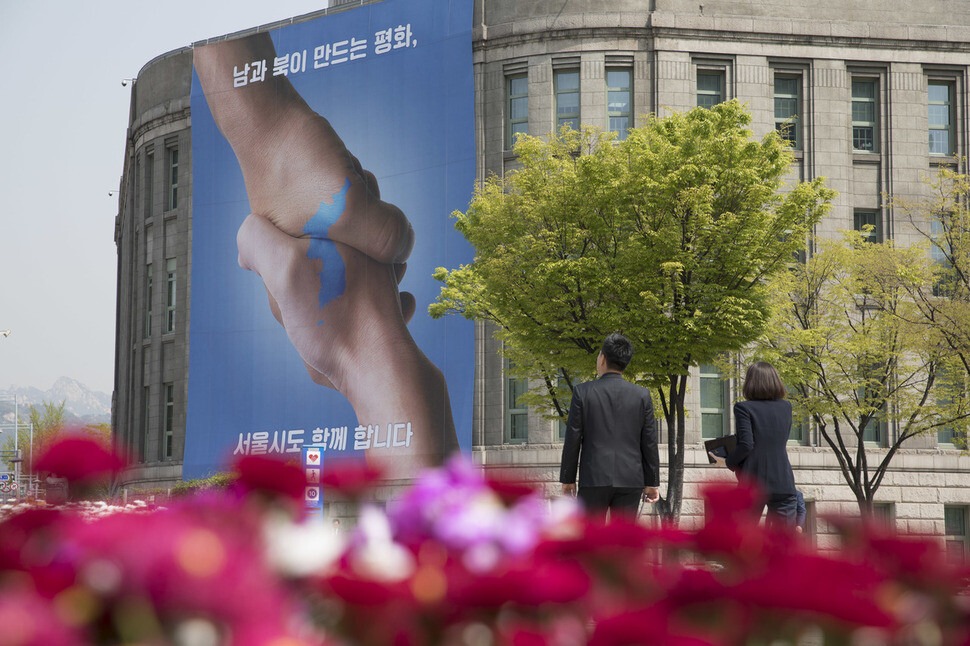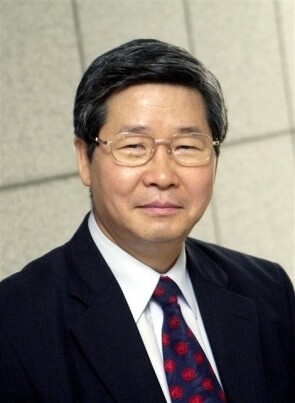hankyoreh
Links to other country sites 다른 나라 사이트 링크
[Column] Comprehensive agreement needed to secure peace on the Korean Peninsula

Following the Pyeongchang Winter Olympics, a spring of peace is coming to the Korean Peninsula that can melt the glacier of the Cold War. This will begin with the inter-Korean summit at Panmunjeom on Apr. 27, but the big question is how that summit can bring about progress on denuclearization and a peace regime on the Korean Peninsula.
Neither of those will be easy. Denuclearization is directly linked to the international system and to the hegemony of the states with a monopoly on nuclear power. A peace regime is inextricably connected to the end of the hostile relationship between North Korea and the United States along with the the continuing existence of the North Korean regime.
Even if a grand bargain is struck on both of those issues during the summit, the specific implementation of such a bargain will require the creation of domestic, bilateral and multilateral institutions. In terms of North Korea’s bilateral relations with the South and with the US, this is a matter of instituting “peaceful coexistence”; on an individual level, with South Korea, North Korea and the US having to move toward creating domestic legislation.
On an international level, there is the matter of creating a multilateral body for security cooperation that can guarantee the implementation of any potential peace agreement. A “peace regime” would include all these things. This is an all-inclusive concept that goes beyond a mere peace treaty (that is, a peace protocol), which would entail the legal cessation of the state of war and the establishment of military trust, and covers a multilateral apparatus for guaranteeing security (that is, a document guaranteeing peace) that would ensure the effectiveness of that treaty.
To summarize, a peace regime consists of a “peace protocol” that includes an apparatus for transitioning from a state of war to a state of peace and to build military trust and a “document guaranteeing peace” that would guarantee that this peace treaty is carried out.
During the denuclearization negotiations, the US is calling for North Korea’s complete, verifiable and irreversible denuclearization (CVID), while North Korea is asking the US to provide a complete, verifiable and irreversible guarantee (CVIG) of a peace regime based on the cessation of hostile relations. A comprehensive and general agreement about this must be reached during the inter-Korean and North Korea-US summits, and this must then be linked to step-by-step gradual implementation measures grounded in domestic law during the subsequent working-level talks.
The ideal approach to peace and unification on the Korean Peninsula is for South and North Korea to be at the center and for Korean neighbors such as the US and China to provide cooperation and a guarantee. In that sense, the most practical course is moving toward a peace regime based on Article 5 of the 1991 Inter-Korean Basic Agreement, which South and North Korea signed in Dec. 1991. In Article 5, they agreed to transition from an armistice agreement to a “firm state of peace” in order to create a peace regime on the Korean Peninsula. Nevertheless, the important Inter-Korean Basic Agreement has still not been ratified by the National Assembly, which is the procedure that would give it domestic authority. North Korea says it has taken steps to give the Basic Agreement domestic authority.
An all-inclusive “peace regime” is preferable to a “peace treaty”
As mentioned previously, an all-inclusive peace regime is more appropriate than a peace treaty, in terms of international law, given the fact that the Korean Peninsula is divided into two governments. The reason is that, according to international law, a peace treaty must include at least three elements: the end of war, the normalization of relations and the resolution of wartime issues (boundaries, prisoners of war and war crimes).
Considering that South and North Korea have endured war and the division of the peninsula for more than 65 years, they may be able to reach an agreement about the first and second elements, but it is extremely doubtful they can do so about the third element, namely the problems that occurred during armed conflict, and in particular the sensitive issues of the demarcation of boundaries and prosecution of war crimes. If these issues are brought up again, they could even lead to a different war.
As a result, a traditional peace treaty is less desirable than a peace regime that takes into account legal issues including the cessation of the war and the normalization of relations, a mechanism for building military trust; and the geo-political angle.
Considering the circumstances on the Korean Peninsula, it would be more practical to have a peace regime including a legal document that declares the end of war and normalizes relations in the legal realm, the establishment of a commission to manage peace on the demilitarized zone and to guarantee the building of military trust, and an international organization (a “multilateral peace and security council”) to guarantee that the aforementioned two elements are carried out. The reason is history offers countless cases, too numerous to list here, in which a peace treaty alone has failed to guarantee peace.
Making a peace protocol based on Article 5 of the Inter-Korean Basic Agreement
At the risk of redundancy, it is necessary to emphasize that South and North Korea make a “peace protocol” based on Article 5 of the Inter-Korean Basic Agreement and to make a “document guaranteeing peace” by which this would be internationally guaranteed by a small number of stakeholders around the Korean Peninsula.
This “peace protocol” between South and North Korea must contain a legal end to the state of war, the normalization of relations in all areas and the peaceful management of the process of division. Furthermore, these two documents must be ratified by the legislatures of the countries in question. This is to ensure the continuation of these documents’ legal status even if new governments come to power in South Korea or the US.

Such a peace regime would be significant as a starting point toward enshrining peaceful coexistence in institutions and domestic law while bring us to the second stage of the roadmap for peaceful unification, which consists of reconciliation, cooperation and peaceful coexistence (a peace system), an inter-Korean confederation (a loose federal system) and “one state for one people.”
By Lee Jang-hee, Professor Emeritus at Hankuk University of Foreign Studies
Please direct questions or comments to [english@hani.co.kr]

Editorial・opinion
![[Column] Season 2 of special prosecutor probe may be coming to Korea soon [Column] Season 2 of special prosecutor probe may be coming to Korea soon](https://flexible.img.hani.co.kr/flexible/normal/500/300/imgdb/original/2024/0426/3317141030699447.jpg) [Column] Season 2 of special prosecutor probe may be coming to Korea soon
[Column] Season 2 of special prosecutor probe may be coming to Korea soon![[Column] Park Geun-hye déjà vu in Yoon Suk-yeol [Column] Park Geun-hye déjà vu in Yoon Suk-yeol](https://flexible.img.hani.co.kr/flexible/normal/500/300/imgdb/original/2024/0424/651713945113788.jpg) [Column] Park Geun-hye déjà vu in Yoon Suk-yeol
[Column] Park Geun-hye déjà vu in Yoon Suk-yeol- [Editorial] New weight of N. Korea’s nuclear threats makes dialogue all the more urgent
- [Guest essay] The real reason Korea’s new right wants to dub Rhee a founding father
- [Column] ‘Choson’: Is it time we start referring to N. Korea in its own terms?
- [Editorial] Japan’s rewriting of history with Korea has gone too far
- [Column] The president’s questionable capacity for dialogue
- [Column] Are chaebol firms just pizza pies for families to divvy up as they please?
- [Column] Has Korea, too, crossed the Rubicon on China?
- [Correspondent’s column] In Japan’s alliance with US, echoes of its past alliances with UK
Most viewed articles
- 11 in 5 unwed Korean women want child-free life, study shows
- 2AI is catching up with humans at a ‘shocking’ rate
- 3[Editorial] Yoon cries wolf of political attacks amid criticism over Tokyo summit
- 4[Photo] “Comfort woman” survivor calls on president to fulfill promises
- 5“Japan’s No. 1 salesman”: Korean groups blast president’s treatment of forced laborers
- 6Yoon calls 60+ hour workweek “unreasonable,” orders revamp of policy
- 7[Editorial] Yoon’s white flag on historical disputes with Japan backfires immediately
- 8‘We must say no’: Seoul defense chief on Korean, USFK involvement in hypothetical Taiwan crisis
- 9[Special reportage- part I] Elderly prostitution at Jongmyo Park
- 10[Photo] More Sewol paintings by Hong Sung-dam